 A recent rise in suspected horse poisonings has brought new attention to creeping indigo (Indigofera spicata), a toxic plant which has reportedly been in Florida for as long as 90 years. This new 5-page fact sheet covers plant description, signs of creeping indigo toxicity, and roles of creeping indigo’s toxins, as well as treatment and management. Written by Robert MacKay, Ed Jennings, Brent Sellers, Jason Ferrell, and Amanda House, and published by the UF Department of Agronomy, August 2015.
A recent rise in suspected horse poisonings has brought new attention to creeping indigo (Indigofera spicata), a toxic plant which has reportedly been in Florida for as long as 90 years. This new 5-page fact sheet covers plant description, signs of creeping indigo toxicity, and roles of creeping indigo’s toxins, as well as treatment and management. Written by Robert MacKay, Ed Jennings, Brent Sellers, Jason Ferrell, and Amanda House, and published by the UF Department of Agronomy, August 2015.
http://edis.ifas.ufl.edu/ag399
Tag: Fabaceae (taxonomic family)
Hairy Indigo Control in Peanut
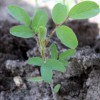 Hairy indigo is an annual legume that was introduced to Florida as a forage crop. It has since escaped cultivation and can be a troublesome weed in some crop settings, particularly in peanut production, since we are attempting to control a legume weed in a legume crop. This 2-page fact sheet was written by Jason Ferrell, Blaire Colvin, and Ramon Leon, and published by the UF Department of Agronomy, March 2015. (Photo by Blaire Colvin, UF/IFAS)
Hairy indigo is an annual legume that was introduced to Florida as a forage crop. It has since escaped cultivation and can be a troublesome weed in some crop settings, particularly in peanut production, since we are attempting to control a legume weed in a legume crop. This 2-page fact sheet was written by Jason Ferrell, Blaire Colvin, and Ramon Leon, and published by the UF Department of Agronomy, March 2015. (Photo by Blaire Colvin, UF/IFAS)
http://edis.ifas.ufl.edu/ag391
Gleditsia aquatica, Water Locust (FOR301/FR369)
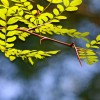 Water locust’s wide, spreading root system and affinity for hydric conditions makes it a useful specimen for erosion control on wet banks of freshwater systems. While not widely available, planting this tree in residential yards or other public locations may be less than ideal, since the long and sharply pointed thorns on the main trunk and branches can be hazardous. This deciduous tree is native to Florida. This 2-page fact sheet was written by Michael G. Andreu, Melissa H. Friedman, and Robert J. Northrop, and published by the UF Department of School of Forest Resources and Conservation, July 2012.
Water locust’s wide, spreading root system and affinity for hydric conditions makes it a useful specimen for erosion control on wet banks of freshwater systems. While not widely available, planting this tree in residential yards or other public locations may be less than ideal, since the long and sharply pointed thorns on the main trunk and branches can be hazardous. This deciduous tree is native to Florida. This 2-page fact sheet was written by Michael G. Andreu, Melissa H. Friedman, and Robert J. Northrop, and published by the UF Department of School of Forest Resources and Conservation, July 2012.
http://edis.ifas.ufl.edu/fr369
Cassia grandis, Pink Shower (FOR294/FR362)
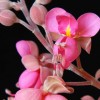 The name “pink shower” comes from the bright pink blossoms that this tree produces. It is sometimes called “stinking tree” because the pulp in its pods has a very strong smell. This 2-page fact sheet was written by Michael G. Andreu, Melissa H. Friedman, and Robert J. Northrop, and published by the UF Department of School of Forest Resources and Conservation, July 2012.
The name “pink shower” comes from the bright pink blossoms that this tree produces. It is sometimes called “stinking tree” because the pulp in its pods has a very strong smell. This 2-page fact sheet was written by Michael G. Andreu, Melissa H. Friedman, and Robert J. Northrop, and published by the UF Department of School of Forest Resources and Conservation, July 2012.
http://edis.ifas.ufl.edu/fr362
Cassia leptophylla, Gold Medallion Tree (FOR295/FR363)
 The gold medallion tree is planted primarily as a shade tree or as a decorative specimen for the yard or street. Many people like this tree because of its fast growth rate and showy, bright yellow clusters of flowers that bloom in the summer months. This tree loses its leaves for a very short period each year, but leaves are quickly replaced. Pruning the tree to one main leading stem from which major branches are attached can help increase its strength and sturdiness against strong wind events. The golden medallion tree is also naturally pest resistant, and as long as it is grown in areas where the temperature does not drop below freezing, it is an easy tree to care for. This 2-page fact sheet was written by Michael G. Andreu, Melissa H. Friedman, and Robert J. Northrop, and published by the UF Department of School of Forest Resources and Conservation, July 2012.
The gold medallion tree is planted primarily as a shade tree or as a decorative specimen for the yard or street. Many people like this tree because of its fast growth rate and showy, bright yellow clusters of flowers that bloom in the summer months. This tree loses its leaves for a very short period each year, but leaves are quickly replaced. Pruning the tree to one main leading stem from which major branches are attached can help increase its strength and sturdiness against strong wind events. The golden medallion tree is also naturally pest resistant, and as long as it is grown in areas where the temperature does not drop below freezing, it is an easy tree to care for. This 2-page fact sheet was written by Michael G. Andreu, Melissa H. Friedman, and Robert J. Northrop, and published by the UF Department of School of Forest Resources and Conservation, July 2012.
http://edis.ifas.ufl.edu/fr363
Cassia afrofistula, Kenyan Cassia (FOR296/FR364)
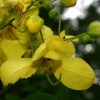 The Kenyan cassia can be used as a showy ornamental tree or shrub, with its dark foliage and bright yellow flowers. Some people find the seed pods to be unattractive and prune the tree after it flowers to prevent pods from developing. This tree tolerates a wide range of soil types and can be used in a garden, park, patio, or streetscape setting. This 2-page fact sheet was written by Michael G. Andreu, Melissa H. Friedman, and Robert J. Northrop, and published by the UF Department of School of Forest Resources and Conservation, July 2012.
The Kenyan cassia can be used as a showy ornamental tree or shrub, with its dark foliage and bright yellow flowers. Some people find the seed pods to be unattractive and prune the tree after it flowers to prevent pods from developing. This tree tolerates a wide range of soil types and can be used in a garden, park, patio, or streetscape setting. This 2-page fact sheet was written by Michael G. Andreu, Melissa H. Friedman, and Robert J. Northrop, and published by the UF Department of School of Forest Resources and Conservation, July 2012.
http://edis.ifas.ufl.edu/fr364
Leucaena leucocephala, White Leadtree (FOR299/FR367)
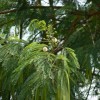 In Florida, white leadtree is a prohibited species and therefore is not used in commercial applications in the state. However, in its native range it is used as a source of charcoal, fuel, and lumber. It has also been planted as a windbreak for crops such as coffee and cocoa, and some ranchers use the tree as a source of both shade and forage for cattle, with the pods being an excellent source of protein. In addition, as white leadtree forms a well-developed taproot, it has been planted to assist with erosion control. This 2-page fact sheet was written by Michael G. Andreu, Melissa H. Friedman, and Robert J. Northrop, and published by the UF Department of School of Forest Resources and Conservation, July 2012.
In Florida, white leadtree is a prohibited species and therefore is not used in commercial applications in the state. However, in its native range it is used as a source of charcoal, fuel, and lumber. It has also been planted as a windbreak for crops such as coffee and cocoa, and some ranchers use the tree as a source of both shade and forage for cattle, with the pods being an excellent source of protein. In addition, as white leadtree forms a well-developed taproot, it has been planted to assist with erosion control. This 2-page fact sheet was written by Michael G. Andreu, Melissa H. Friedman, and Robert J. Northrop, and published by the UF Department of School of Forest Resources and Conservation, July 2012.
http://edis.ifas.ufl.edu/fr367
Cassia javanica, Pink and White Shower (FOR297/FR365)
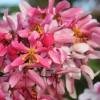 Cassia javanica is planted primarily as a decorative shade tree. Many people consider pink and white shower to be aesthetically pleasing because of its pink and white blooms that emerge during the summer months. Because its leafless season is so short, it can be a good shade tree throughout the year. Its rapid growth rate makes it an ideal tree for homeowners looking to increase their tree cover. And its natural resistance to pests increases its desirability as a landscape tree that is commonly used as an ornamental street tree. This 2-page fact sheet was written by Michael G. Andreu, Melissa H. Friedman, and Robert J. Northrop, and published by the UF Department of School of Forest Resources and Conservation, July 2012.
Cassia javanica is planted primarily as a decorative shade tree. Many people consider pink and white shower to be aesthetically pleasing because of its pink and white blooms that emerge during the summer months. Because its leafless season is so short, it can be a good shade tree throughout the year. Its rapid growth rate makes it an ideal tree for homeowners looking to increase their tree cover. And its natural resistance to pests increases its desirability as a landscape tree that is commonly used as an ornamental street tree. This 2-page fact sheet was written by Michael G. Andreu, Melissa H. Friedman, and Robert J. Northrop, and published by the UF Department of School of Forest Resources and Conservation, July 2012.
http://edis.ifas.ufl.edu/fr365